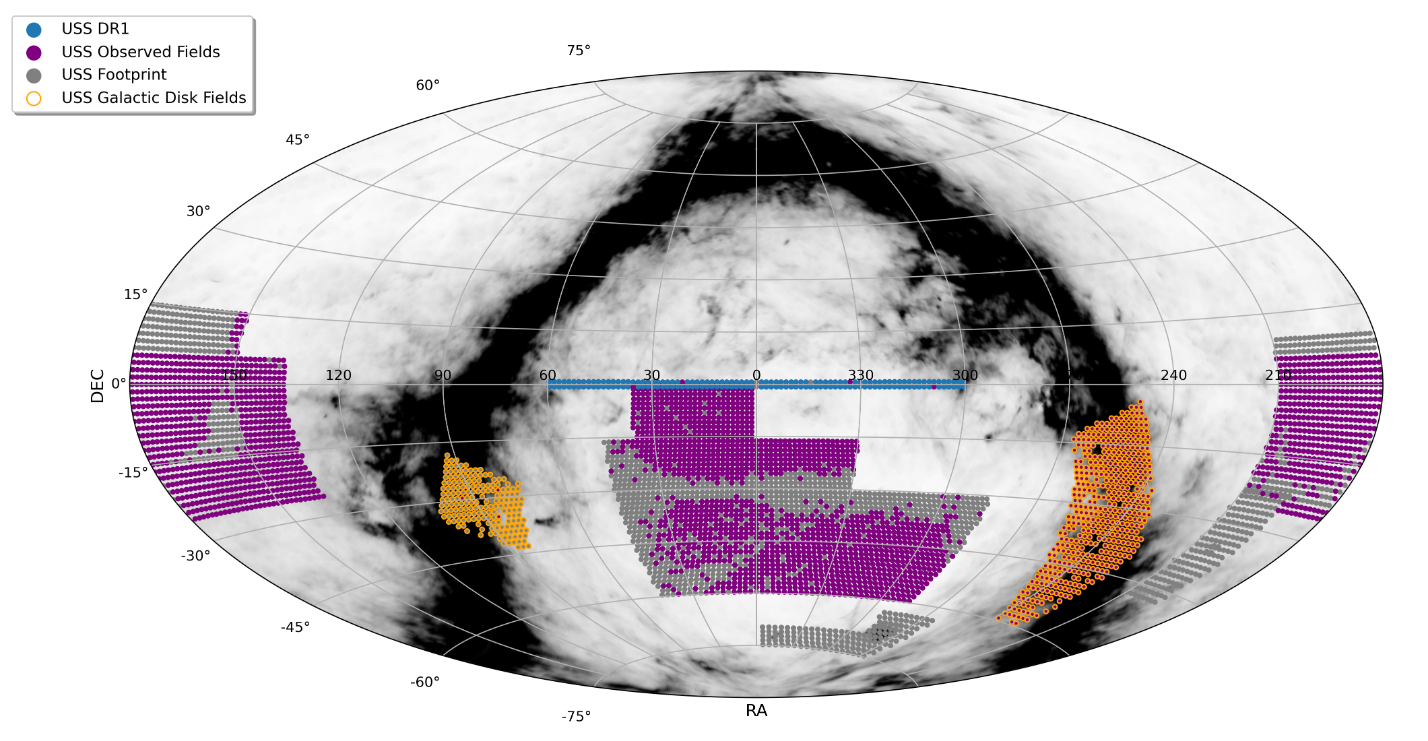S-PLUS Ultra Short Survey
Searching the Milky Way for bright metal-poor stars.

In the beginning of the Universe, just after the Big Bang, matter was made only of the chemical elements hydrogen and helium (with some lithium and trace amounts of a few other light elements). All the other chemical elements that we known today (such as the oxygen that we breath and the iron in our blood) were produced later by the stars. The amount of these elements increased gradually with time, as successive generations of stars formed, produced new elements by nuclear reactions in their interiors, and expelled at least part of these new elements back to the insterstellar medium, either by winds during their lives or exploding as they died. The new elements were then used in the formation of the next generation of stars. Many generations of stars were needed to produce the material that now makes the Sun, the Earth, and ourselves.
However, stars that astronomers classify as having a low mass (equivalent to the mass of the Sun or smaller) can live for 10 billion years or more. This means that low-mass stars formed in the beginning of the Universe are still present today. These ancient stars still have in their atmospheres a chemical composition that reflects the time at which they formed. A time when the amount of chemical elements was very different from what we see in young stars today. The study of the chemical composition of these old stars can give clues about the early Universe, the first generations of stars that disappeared long ago, and reveal how the Milky Way evolved to its present-day shape and chemical composition.
The search for old metal-poor stars
These old and metal-poor stars (generically, astronomers tend to call everything that is not hydrogen or helium as metal) are important fossil records to study our Galaxy. However, they are very rare around the Sun. They are usually located at far distances at the halo of the Milky Way. The halo of the Milky Way is an extended and roughly spherical region, sparsely populated by stars, that surrounds the Galactic disc. Because of their importance, astronomers have been searching for examples of metal-poor stars for a long time. By the mid-1980s, only two examples of stars with about one thousandth (1/1000) the amount of metals in the Sun were known. Nowadays, between 400 to 500 of stars with such amount of metals or lower are known. These is a very small number, particularly when we remember that the Milky Way has between 100-400 billion stars.
The best way to determine the amount of metals in a star is to take its spectrum. The chemical elements create lines in the spectrum and these lines can be modelled to infer the amount of metals that the star has. Taking spectra of distant (and therefore faint) stars is very difficult and requires long observations. It would take prohibitive amount of time to survey billions of stars using spectroscopy, just to find out which ones are metal poor. On the other hand, taking images of the sky (an observational technique known as photometry) is much faster. This is what the S-PLUS Ultra Short Survey (among other projects) is doing.
The S-PLUS USS
S-PLUS stands for Southern Photometric Local Universe Survey. The S-PLUS project is a photometric survey done in a set of 12 bands (seven narrow and medium-band filters and five broad-band filters) using a 0.826m robotic telescope (called T80-South or T80S), at the Cerro Tololo Inter-American Observatory (CTIO) in Chile, at an altitude of approximately 2200 meters. Images are taken with a wide-field camera that has a field of view of 1.4 by 1.4 degrees and uses a CCD of 9232 x 9216 pixels.
The Ultra-Short Survey (USS) is one of many sub-surveys in the S-PLUS project. USS covers the same area as the overall S-PLUS Main Survey, but with much shorter exposure times. The primary objective of the USS is to identify bright, extremely metal-poor (those with about 1/1000th the amount of metals of the Sun) and ultra metal-poor (those with about 1/10000th the amount of metals of the Sun) stars for further analysis using medium- and high-resolution spectroscopy. Stars of low metallicity are more "transparent" to light than stars of higher metal content (its the high content of metal that makes it harder for light to leave the star). Because of that, metal-poor stars tend to have bluer colours compared to metal-rich stars. Moreover, some of the bands used for imaging of the sky focus on strong metal absorption lines that are weaker in metal-poor stars. Therefore, the images taken in the different bands of S-PLUS enable a comprehensive characterization of objects and at least a qualitative indication of which objects are good candidates of being metal-poor stars.
The results
This first data release (DR1) of USS includes observations of 163 fields along the Celestial Equator (the blue points in the image; the dark region indicates the Galactic disk). The images cover a total area of ∼ 324 deg2, across all 12 bands. Other fields have been observed and are under analysis. The catalogue released in DR1 contains approximately 1 million detected objects. Of those, about 63000 sources are relatively bright and have a magnitude in the "r" band smaller than 14. Further analysis of the data (described in the publication) identified a total of 140 candidates for EMP or UMP stars. This sample will be targeted with spectroscopy in follow-up studies. If their status as metal-poor stars is confirmed, they will significantly increase the number of known metal-poor objects in the Milky Way (which is currently between 400-500 stars, as mentioned above). Future USS data releases are expected to provide data for thousands of additional fields and have an even bigger impact on this are of astronomy.
Text by Rodolfo Smiljanic
